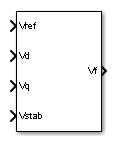Excitation System
(To be removed) Provide excitation system for synchronous machine and regulate its terminal voltage in generating mode
The Specialized Power Systems library will be removed in R2026a. Use the Simscape™ Electrical™ blocks and functions instead. For more information on updating your models, see Upgrade Specialized Power System Models to use Simscape Electrical Blocks.
Libraries:
Simscape /
Electrical /
Specialized Power Systems /
Electrical Machines /
Synchronous Machine Control
Description
The Excitation System block is a Simulink® system implementing a DC exciter described in [1], without the exciter's saturation function. The basic elements that form the Excitation System block are the voltage regulator and the exciter.

The exciter is represented by the following transfer function between the exciter voltage Vfd and the regulator's output ef:
Ports
Input
Output
Parameters
References
[1] “Recommended Practice for Excitation System Models for Power System Stability Studies,” IEEE® Standard 421.5-1992, August, 1992.
Extended Capabilities
Version History
Introduced before R2006a
